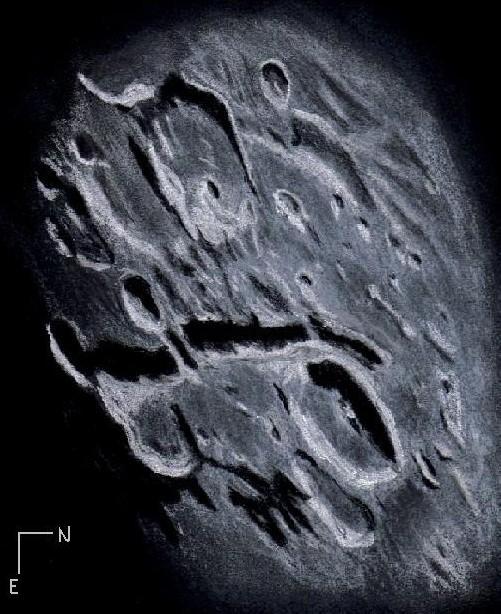
The Aristarchus Plateau
By Frank McCabe
The Aristarchus Plateau
The 3.6 billion year old Aristarchus plateau is a raised, tilted polygonal block
of crust in the ocean of storms with a collection of interesting features that can
be seen with telescopes of all sizes. Crater Aristarchus left of center is a large
(41 km.) 3.2 km. deep crater that is bright, young (500 million years old) and
sits near the SE edge of the plateau. Lunar Prospector spacecraft back in 1998-99
detected radon gas being released from this region. The Space Telescope Science
Institute along with Northwestern University and others conducted an ultraviolet
and visible light analysis using the Hubble telescope to detect the presence of
titanium oxide near crater Aristarchus. This could be a potential source of oxygen
on the lunar surface and also a source of titanium metal.
I remember well my disappointment when Apollo 18, 19 and 20 were cancelled in
1970. Apollo 18 was scheduled to land on the Aristarchus plateau near Schroter
valley. Schroter valley is an old Imbrium (3.5 billion years old) volcanic
feature that begins at the famous cobra head 25 km. north of ancient crater
Herodotus. This feature meanders north then west then southwest for more than 150
km. The bend is nearly 170 degrees. It is also large enough to be seen in a 2
inch telescope under conditions of good seeing.
The region surrounding the beginning of Schroter valley was carefully imaged March
3rd and April 27th in 1994 by Clementine spacecraft because of reported color
changes. Clementine confirmed these changes were real. This region of the moon
shows color visible to some observers. It is described as reddish or yellowish by
those that can see this color.
Don’t think of the moon as an annoyance that spoils galaxy hunting as some deep
sky enthusiasts sometimes do, but embrace it as the beautiful satellite it is,
awaiting observation and exploration.
Sketch:
Graphite pencil, pen and ink sketch on copy paper 8.5”x11”
Date: 1-2-2007 1:50 to 3:45 UT
Temperature: -1.2 °C (30° F)
Calm, seeing good for this part of Illinois
Antoniadi mostly IV briefly III
13.1 inch f / 5.9 Dobsonian 6mm ortho ocular 327X
Colongitude: 66.8°
Lunation: 12.5 days
Illumination: 97%


